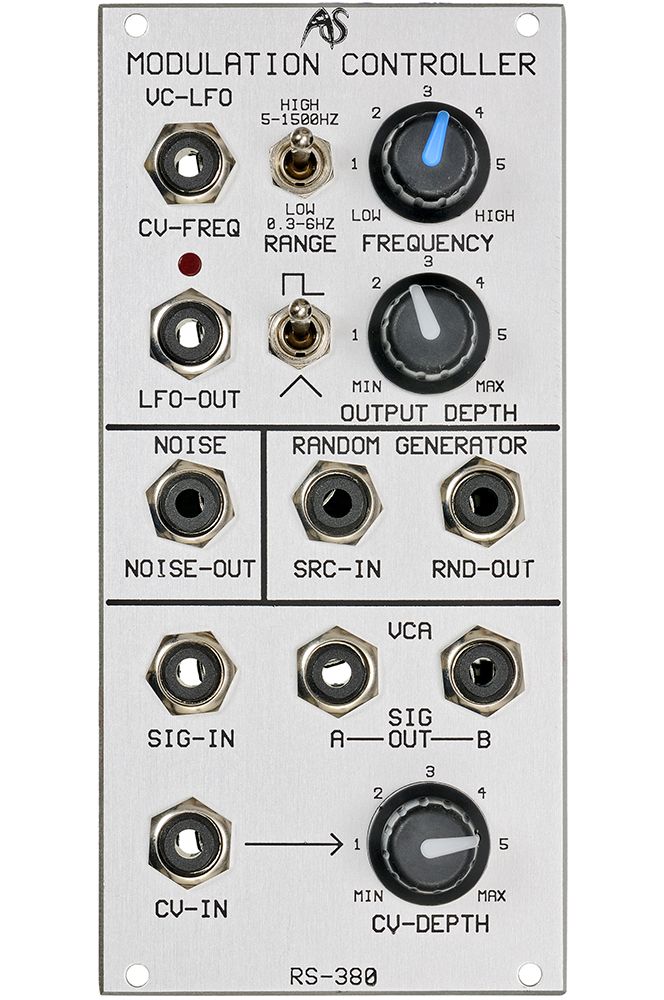Analogue Systems
RS-380
Modulator
Multifunction module containing LFO, sample and hold, noise and VCA. Incredibly versatile unit as well as excellent modulation controller when used in conjunction with Demon and Sorcerer and other analogue keyboards with mod wheel or joystick capabilities. Cost effective and rack space efficient.
The RS-380 is a composite module comprising four separate ‘sub-modules’ that you can patch together or with other RS Integrator modules to generate and control a wide range of effects.
It is designed for use when space is at a premium, and combines a flexible Voltage Controlled Low Frequency Oscillator (VC-LFO) with a noise generator, a Voltage Controlled Amplifier (VCA) and a random signal (sample & hold) generator.
Voltage controlled LFO with two selectable frequency ranges: LOW goes from 0.3Hz to 6Hz and HIGH from 5Hz to 1.500Hz; using control voltages you can reach lower and higher frequencies, though. The CV input is not compliant to the 1V/octave characteristic. Two waveforms are available: square and triangle.
Analog noise generator that produces white noise.
Sample & Hold: due to normalized sockets you can use this sub-module without patching as the LFO´s square wave and the white noise are pre-patched. Alternatively you can insert other signals than the internal white noise through the Source In socket.
VCA: classic VCA with one signal input, two signal outputs and one CV input.
In use :
VC-LFO
The VC-LFO offers a very low minimum frequency that allows you to create a variety of varying modulations and effects. Its maximum frequency lies in the middle of the audio range. The RS-380N VC-LFO can, therefore, be used in three ways: as a low frequency modulator; as an audio frequency modulator; and as a secondary sound source.
Note: The CV FREQ input does not conform to the 1V/oct standard so you will not be able to use it as a conventional oscillator.
-
FREQUENCY:
The FREQUENCY knob has two ranges:
HIGH: Turning the FREQUENCY control from its minimum to its maximum will cause the VC-LFO to produce its upper range of frequencies from 5Hz to 1,500Hz.
LOW: Turning the FREQUENCY control from its minimum to its maximum will cause the VC-LFO to produce its lower range of frequencies from approximately 0.3Hz to 6Hz.
You may control the VC-LFO rate by applying a suitable CV to the CV FREQ socket. In doing so, you may extend the maximum and minimum frequencies well beyond the ranges quoted above. This is normal.
-
WAVEFORMS:
The RS-380 generates two waveforms, although you can not use these simultaneously. The first of these is the triangle wave, which is often used for imitating acoustic characteristics such as vibrato and tremolo. The square wave is suitable for acoustic effects such as trills, as well as for controlling many other aspects of the synthesiser.
TRIANGLE: The level of the triangle wave is controlled using the associated OUTPUT DEPTH control, and has a maximum output of approximately ±2.5V.
SQUARE WAVE: The level of the square wave is controlled using the associated OUTPUT DEPTH control, and has a maximum output of approximately ±5V
-
STATUS LED:
The status LED gives you a visual indication of the LFO frequency.
NOISE
Unlike a standard oscillator, a white noise generator requires no controls for its waveform or its frequency. There is, therefore, just a single output, which carries the noise signal. There are no controls, and no inputs.
-
NOISE OUT:
The noise is output from the NOISE-OUT socket.
RANDOM GENERATOR
The RANDOM GENERATOR incorporates a highly stable S&H circuit that will sustain a constant voltage almost indefinitely. The S&H Clock is derived exclusively from the RS-380's internal VC-LFO. There is just one input, the source signal input (SRC IN); and a single output.
-
SRC IN:
This input accepts signals in the range ±10V. These signals may be CVs or audio signals, and may be generated within the RS Integrator or presented by outside sources such as CDs, microphones, or other musical instruments. If the signal amplitude is too low for effective use as a source, you can use the Pre-Amp sub-module in the RS-70 to boost it to an appropriate level.
If no signal is presented to SRC IN, the RANDOM GENERATOR derives its source from the RS-380's NOISE generator. This is pre-patched internally, so you do not need to use a cable to make this connection
-
RND OUT:
Sampled voltages are output here. The maximum signal amplitude lies in the range ±6V.
VOLTAGE CONTROLLED AMPLIFIER
Amplifiers have a simple job - they amplify or attenuate the signals presented to them. Voltage controlled amplifiers (VCAs) are more sophisticated... they allow you to control the amount of amplification or attenuation by applying a voltage to a CV input. VCAs exist in every synthesiser that can shape a sound.
You may think that it's the envelope that is, for example, changing the volume, but it isn't. The envelope is producing a CV that, when applied to a VCA, causes it to modify the signal passing through it. The VCA is one of the fundamental modules that allow us to make sounds develop over time.
-
SIG IN:
This accepts audio signals and CVs in the range ±10V. The signal presented to this input is the signal that will be amplified by the VCA.
-
CV-IN and CV-DEPTH:
The CV-IN input accepts audio signals and CVs in the range ±10V. The signal presented to this input is the signal that will affect the gain of the VCA.
You can adjust the depth of the CV-IN signal using the associated CV-DEPTH control.
-
SIG OUT A and B:
There are two outputs. These carry the same signal in the range ±10V.
